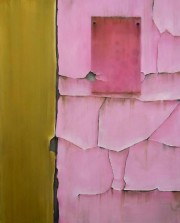All That’s Left Behind: Painting Pornography and a New Poland
Room 1
The Silent Book, 2011
Slawomir Elsner’s The Silent Book is likely to be the first painting you encounter upon entering the Marc Jancou Contemporary gallery. It is so effective it looks as though the paint is peeling right off the canvas like chipped nail polish. The pink and yellow are appealing, but then it becomes clearer upon taking a closer look that the yellow is mustardy and graded, darker at the bottom. The cracks in the pink bleed rust. And instead of a decrepit sign, there is only the outline, or negative space, of where one must have been.
And so begins a tour of closer inspection and pushing the far-sighted, rose-colored glasses to the top of one’s head to get a better look at the Collecting Images exhibition of the Berlin-based Polish painter.
Capital, 2001
There is another binary in Capital—in this case of minimalist white on black, with a clear, divisive line splitting the canvas in half. Leaning against the wall in the painting is a messy stack of vibrant canvases depicting medieval Krakow in colors fit for a farmwife’s scarf. This juxtaposition of modern versus traditional is an apt commentary on the tensions between globalization and tradition in the new Poland.
This is an exhibition of remnants: ripped pages, faded walls; strips of solid colored wallpaper curling at their torn edges reveal a hidden classical painting underneath. The whole exhibit is a (new) Polish whitewash—bright colors bought in bulk at Benjamin Moore, right next door to the mega-Sephora on Nowy Świat (a main drag in Warsaw, Poland dubbed the New World) where you can buy Essie’s Movers and Shakers pink nail polish before it chips away. But how many coats does it take to cover ten centuries of struggle and resistance? Elsner appears less concerned with this cover-up, and instead focuses on presenting it as it exists, and then ripping it away again to show what is still vibrant underneath.
Room 2
The extension of the exhibition poses a different conflict: a series of pornographic images with the explicit section “ripped” out. Elsner paints negative space so realistically that the gaping hole looks fresh and even aggressive in its large scope and with its torn edges. Large chunks of the paintings are “missing,” and yet the viewer can virtually superimpose what would have been there, similarly to how we surprise ourselves with how easy it is to read a sentence without vowels. Our imagination is given clues with reflections in mirrors and small snippets of a heel or stocking to imply the gender of the participants in the sexual act we are (not quite) witnessing.
Elsner’s is a clever way to portray pornography and recreate the associated voyeuristic fascination. One might expect graphic imagery to be at the root of the shame some feel in engaging with pornography, and with the taboo and explicitness gone, so is the awkwardness of standing before such an image in a public space. But this removal is almost incidental, as Elsner proves how effective our imagination can be in filling in the gaps so that the paintings appear almost complete. The power of innuendo and society’s unspoken commentary are just as salient. The paintings are proof that perhaps a sexual act, or even its representation, is not actually as powerful as the mere hint of its presence.
So able are we to fill in the missing pieces that the sexual acts that were stripped away might as well still be there. But they aren’t.
And with this amputation of period-piece porn (specifically that of the 1970s), Elsner presents us with another conflict: how sex was portrayed during a revolution of expression versus how we regard it today. How we let ourselves view it and how society manages our spectatorship and pornography’s public presence. And just how creative can we get?

